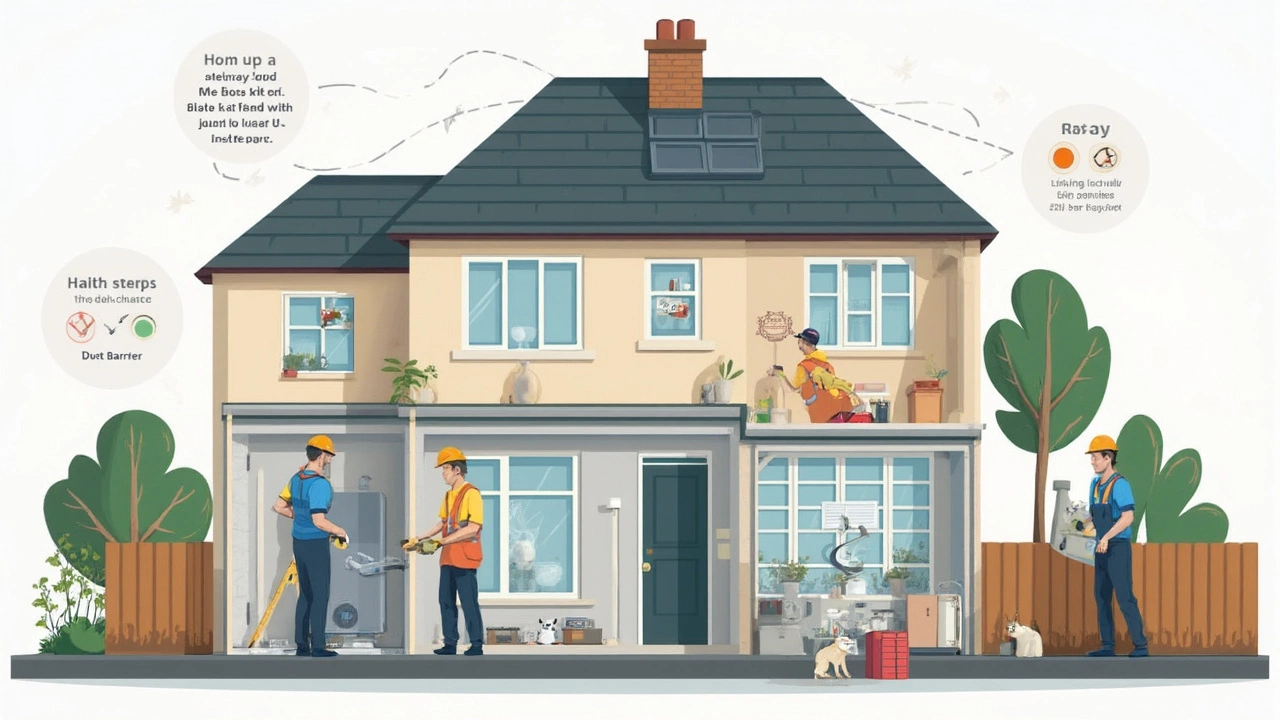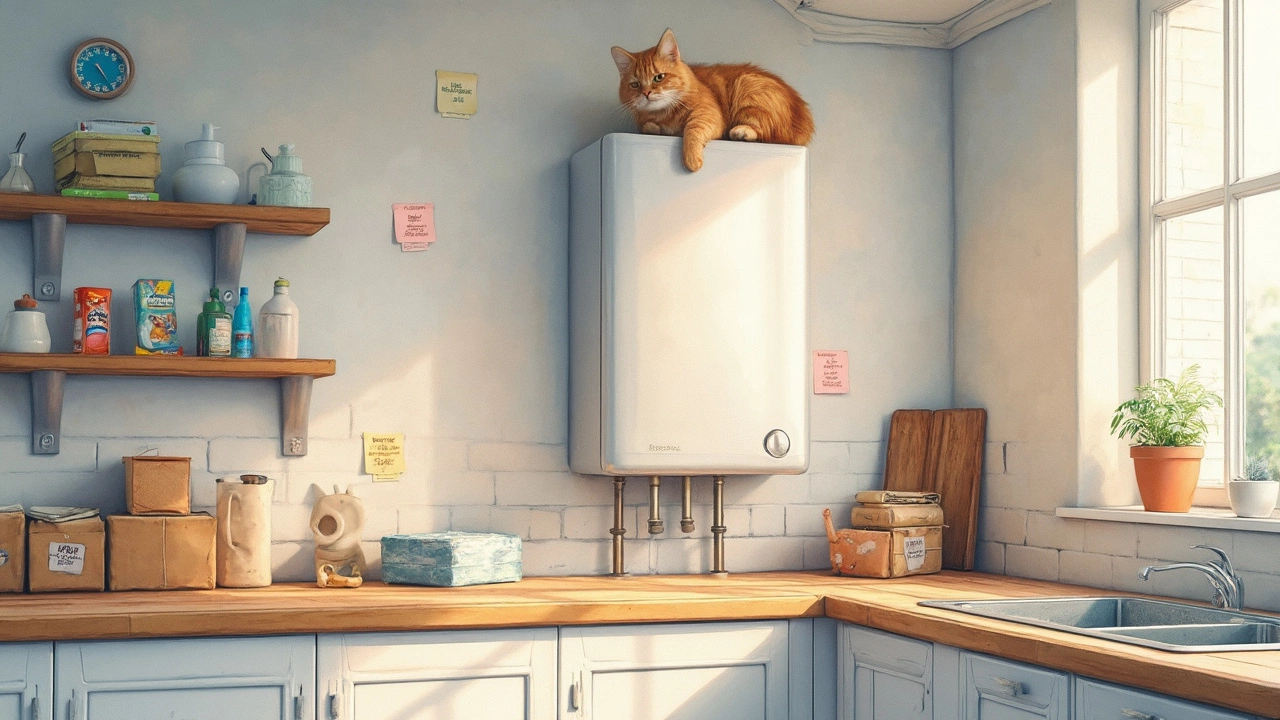If you’ve ever had to swap out an old boiler, you’ve heard the warnings—it’s supposed to be a total mess, right? Pipes clattering on the floor, dust everywhere, maybe the odd muddy footprint on your stairs.
But here’s what people don’t usually mention: yes, there will be a bit of chaos, but most of it is totally manageable with the right prep. Most good installers will do their best not to trash your place. Still, you should expect some noise, dust, and the odd bit of debris, especially if your old boiler’s in a tricky spot or has stubborn pipe connections.
The level of mess mostly depends on three things—how easy your old boiler is to reach, how much pipework needs doing, and whether you’re swapping locations in the house. Kitchens and airing cupboards tend to keep things simple and faster, but putting in new radiators or extra pipes can mean floorboards come up or walls get knocked through. That’s when things tip over from a bit hectic to “why did I wear white socks today?”
- The Boiler Replacement Process Explained
- How Messy Does It Really Get?
- Dealing With Dust, Debris, and Disruption
- What Installers Do To Keep Things Tidy
- Tips to Minimize Mess in Your Home
The Boiler Replacement Process Explained
So, what actually happens when you get your boiler swapped? First, you’ll get a visit from a heating engineer, usually to check out what needs doing and talk about options. They’ll look at your current setup, check the size of your home, and run a few tests—like measuring your water pressure.
The real action starts on the replacement day. The engineer will usually:
- Turn off the gas and power to make the system safe
- Drain down the central heating system, which means water comes out of your pipes and radiators
- Disconnect and remove your old boiler (sometimes, this means a bit of heavy lifting and squeezing through tight spaces)
- Prepare the spot for your new boiler—adjusting pipework if it’s a different size or type, which might mean cutting pipes or even lifting carpets or floorboards
- Install the new boiler and connect it to gas, water, and electric
- Flush the system if needed, which clears out sludge and old rust that could mess up the new unit
- Test everything to make sure it’s safe and working, then show you how to use the controls
The whole process usually takes one to three days. If your home’s old or there’s weird pipework, it can take longer. Moving your boiler to a new spot? That adds steps—more pipework and possible wall drilling. If you’re just replacing an old model with something similar in the same place, things are much quicker and a lot less invasive.
And here’s something most people don’t realize: your strong boiler replacement job usually ends with the engineer registering your new boiler for warranty and building regs, so you don’t have to deal with all the paperwork yourself.
How Messy Does It Really Get?
Let’s cut right to it—replacing a boiler is messier than a TV advert would have you believe, but it’s definitely not a disaster zone every time. It’s about what kind of boiler you have, where it’s installed, and the age of your pipework. Most homes see a mix of dust, a bit of water spillage, and sections of floor or wall exposed.
Here’s what usually happens during a typical boiler replacement:
- Dust and debris: Cutting old pipes or drilling for new ones stirs up dust and sometimes brings out old, chunky bits of plaster. Older homes, where pipes are buried in walls, will definitely see more mess.
- Water spills: Unless the installer is a total pro, there’s a risk of water ending up on the floor during disconnection, especially from old radiators.
- Packaging and parts: Boiler boxes and torn insulation wrappers can pile up around the work zone. Expect a few plastic and cardboard mountains before the installer tidies up.
- Noise and foot traffic: Expect banging, scraping, and doors left open as installers come and go. Dust sheets help, but they aren’t magic shields.
The level of mess grows if your new system involves major upgrades or moving the boiler to another spot. If that’s the case, you might see holes sawed in floors or new pipes chased into walls. For jobs like this, carpenters or plasterers sometimes have to follow after the heating guys to patch everything up.
Here’s a look at how the mess scales up, depending on the details of your project:
| Type of Boiler Job | Mess Level (1-5) | Common Issues |
|---|---|---|
| Like-for-like swap (same place, same type) | 2 | Dust, minor water spills, some noise |
| System upgrade (e.g. regular to combi) | 3 | More pipes, bigger debris, plaster on floors |
| Relocation (new position in home) | 4-5 | Floorboards up, wall chasing, builder cleanup |
The good news is most of the mess sticks to the boiler and pipe areas. Bedrooms and lounges usually stay untouched if you lay down a few dust sheets or ask nicely for extra protection. If you’ve got allergies or pets like my wife Lydia, it’s worth closing doors, covering furniture, and maybe sneaking off for a day out. You’ll dodge the worst of the mess—and your installer won’t trip over the cat.

Dealing With Dust, Debris, and Disruption
The reality is, when you have old pipework being yanked out and a fresh boiler replacement going in, stuff is going to get kicked up. A major thing most folks notice is the dust—old boilers and pipes can hide layers of it you forget even existed. If your boiler’s tucked away behind kitchen units, expect crumbs, pet hair, and years’ worth of lost LEGO blocks to show up.
Most installers bring dust sheets, but they usually just cover the direct working area. You’ll get dust drifting down hallways—especially if floorboards get lifted to swap or re-route pipes. Wood splinters and bits of plaster are par for the course if any drilling is needed for flues or brackets.
One WHICHaudit in the UK found that 82% of customers said there was at least "some" mess after boiler installation. That honestly tracks with most people’s experience. On the plus side, only about 1 in 5 people felt it was “major.” For most, it’s more like mild chaos for a day or two.
- Expect steps like:
- Installers moving furniture or kitchen items near the boiler
- Use of hand tools (saws, drills, wrenches) that can leave shavings and dust everywhere
- If it’s winter, muddy boots are common. Ask about shoe covers if it bothers you!
- If your flooring is delicate, point it out early. Roll up rugs and stash them out of the work zone
Check out this quick breakdown of what usually causes the disruption and how long each takes:
| Task | Mess Level | Avg. Duration |
|---|---|---|
| Boiler Removal | Medium - loose dust, old insulation flakes | 1-2 hrs |
| Piping Work | High (if boards/walls opened) | 2-4 hrs |
| Flue Installation | Medium - masonry/brick dust | 1-2 hrs |
| System Testing | Low | 30 min |
Noise is its own kind of mess too. Drilling into brick or concrete for a new flue is LOUD. If you need to take calls or have little ones napping, let your fitter know so they can warn you before it gets noisy. Sometimes, you’ll hear water draining out—especially clanky with older radiators.
If you’re working from home or have pets, be ready to shift your base for a day. Trust me, having your dog jumping over toolbags while you’re trying to join a Zoom meeting never ends well. Snack tip: Seal food or crockery in another room until the dust settles so you don’t end up crunching on drywall bits at lunch!
What Installers Do To Keep Things Tidy
Every good installer knows nobody wants their living room looking like a construction site after a boiler replacement. Keeping your house clean isn’t just polite—it’s part of the job. There’s a surprising amount that installers do behind the scenes to control the mess and keep your stress levels down.
First off, they’ll usually show up with dust sheets and plastic sheeting. Before any tools come out, they’ll lay these down along the main walkways and around the work area. Some even use sticky plastic film on carpets, which grabs dirt from boots and saves you from hours of hoovering later.
They also bring vacuum cleaners or dust extractors. If they’re drilling, sawing, or working in tight cupboards, you’ll often hear that vacuum humming in the background. Good installers will also sweep up any mess as they go, not just at the end.
Pipes get drained and capped to avoid leaks on your floors. Water stops are put in place before the old boiler is removed, cutting the odds of an accidental mini-flood. Some teams work in pairs—so one person fits pipework while another keeps on top of the tidying, especially in tight or awkward spaces. This helps things run smoother and keeps dust spreading to a minimum.
- Dust sheets and plastic sheeting protect your flooring and furniture.
- Vacuum cleaners and brooms are used during and after work to tackle dust.
- Protective covers go on shoes or boots—handy if it’s been raining outside.
- Tools and spare parts get unpacked and stacked in one place, not scattered around your home.
- Installers double-check for leaks, stray screws, or bits of wire before packing up for the day.
Before leaving, any half-decent company will walk you through the changes, point out anything to keep an eye on, and help with bigger clean-up jobs if things got dirtier than normal, like after taking out a really old or leaky unit. So, if you hear stories from someone who ended up with grime everywhere, there’s a good chance their installer cut corners or just wasn’t a tidy worker.

Tips to Minimize Mess in Your Home
There are some straightforward ways to cut down on the disruption when you’re getting a boiler replacement. You don’t need to go overboard, but a little prep makes all the difference.
First thing: cover your stuff. Grab some dust sheets or even old bedsheets, and cover anything nearby—furniture, electronics, or anything you care about that might catch stray droplets or debris. Installers usually bring their own protective coverings too, but doing a quick check the night before can save some worry.
Next, clear the work areas. Move shoes, jackets, dog beds, or anything else that sits in the hallway and spaces the installers will use. If they have clear pathways, they’re less likely to leave muddy footprints or knock something over.
If you can, crack open a window. It might sound obvious, but fresh air makes it a lot easier for both the installers and your own nose. Some jobs might kick up a stronger smell, especially if they're flushing the system or soldering pipes.
When it comes to floors, non-slip dust sheets or plastic sheeting work best, especially across walkways. This protects against dirt, wet spots, and even sharp bits of old pipe or screws.
Experienced installers usually tidy up after themselves, but there’s no harm in asking up front. It’s honestly worth it to have a two-minute chat before they start to set your expectations. Good ones won’t take offense—it’s your home, after all.
Last tip—think about pets and kids. Boilers need a bit of space, and tools lying around can be tempting. Most families send the kids to a friend’s house for a few hours, or at least keep the pets in another room until everything’s finished up and cleaned.
- Cover all nearby surfaces with sheets, especially where dust might settle.
- Move valuables and knick-knacks out of the work zone.
- Put away anything you don’t want knocked or covered in dust.
- Let your installer know if there are rooms you really want left untouched.
- Have a vacuum or broom ready—the little bits are easiest to clear straight away.
If you follow these steps, most of the mess stays in one place, and you’ll spend a lot less time cleaning up once the new boiler’s up and running.

I am an expert in the services industry with a focus on appliance repair. My passion lies in understanding how things work and educating others in simple, engaging ways. This enthusiasm fuels my writing, where I delve into topics around appliance maintenance and troubleshooting. I aim to make these subjects clear and accessible to all readers.